香港CPA案例分析大赛题目与答案示例
cpa试题及答案

cpa试题及答案CPA试题及答案一、单项选择题1. 根据美国通用会计准则,以下哪项不属于资产的特征?A. 预期会给企业带来经济利益B. 企业拥有或控制的资源C. 企业已经支付的款项D. 企业未来可能获得的收益答案:D2. 在会计信息系统中,以下哪项不是会计信息的基本要素?A. 资产B. 负债C. 所有者权益D. 现金流量答案:D3. 以下哪项不是财务报表分析的目的?A. 评估企业的财务状况B. 预测企业的财务趋势C. 确定企业的市场价值D. 制定企业的财务计划答案:D4. 会计等式中,资产和负债的关系可以表示为:A. 资产 = 负债 + 所有者权益B. 资产 - 负债 = 所有者权益C. 负债 = 资产 - 所有者权益D. 所有者权益 = 资产 + 负债答案:B5. 以下哪项不是内部控制的组成部分?A. 控制环境B. 风险评估C. 控制活动D. 财务报表答案:D二、多项选择题1. 以下哪些因素可能影响企业的利润?A. 销售收入B. 销售成本C. 管理费用D. 折旧和摊销答案:A, B, C, D2. 以下哪些属于长期负债?A. 银行贷款B. 长期债券C. 应付票据D. 长期应付款答案:B, D3. 以下哪些是现金流量表的主要部分?A. 经营活动产生的现金流量B. 投资活动产生的现金流量C. 筹资活动产生的现金流量D. 非经常性项目答案:A, B, C4. 以下哪些是企业进行财务分析时常用的比率?A. 流动比率B. 速动比率C. 负债比率D. 利润率答案:A, B, C, D5. 以下哪些是企业进行成本控制的方法?A. 标准成本法B. 预算控制C. 直接成本法D. 责任会计答案:A, B, D三、简答题1. 简述会计信息的质量要求有哪些?答:会计信息的质量要求主要包括可靠性、相关性、可理解性、可比性、及时性等。
2. 什么是权责发生制?它与收付实现制有何不同?答:权责发生制是指收入和费用的确认以权利和责任的发生为基础,而收付实现制则是以现金的实际收付为基础。
注会真题案例及解析
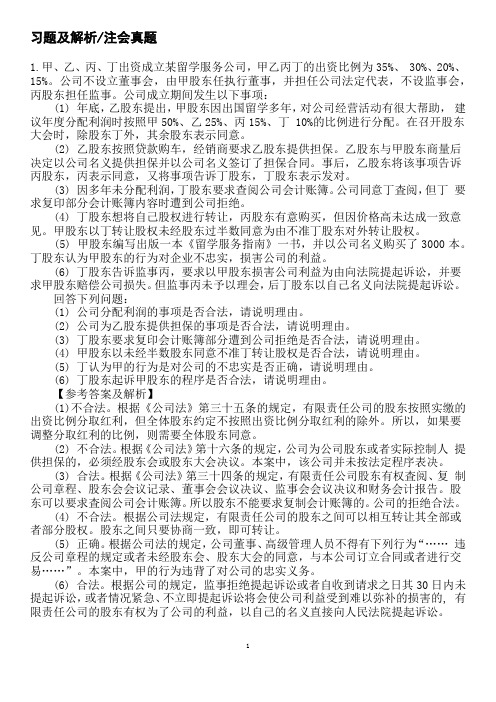
习题及解析/注会真题1.甲、乙、丙、丁出资成立某留学服务公司,甲乙丙丁的出资比例为35%、 30%、20%、15%。
公司不设立董事会,由甲股东任执行董事,并担任公司法定代表,不设监事会,丙股东担任监事。
公司成立期间发生以下事项:(1) 年底,乙股东提出,甲股东因出国留学多年,对公司经营活动有很大帮助,建议年度分配利润时按照甲50%、乙25%、丙15%、丁 10%的比例进行分配。
在召开股东大会时,除股东丁外,其余股东表示同意。
(2) 乙股东按照贷款购车,经销商要求乙股东提供担保。
乙股东与甲股东商量后决定以公司名义提供担保并以公司名义签订了担保合同。
事后,乙股东将该事项告诉丙股东,丙表示同意,又将事项告诉丁股东,丁股东表示发对。
(3) 因多年未分配利润,丁股东要求查阅公司会计账簿。
公司同意丁査阅,但丁要求复印部分会计账簿内容时遭到公司拒绝。
(4) 丁股东想将自己股权进行转让,丙股东有意购买,但因价格高未达成一致意见。
甲股东以丁转让股权未经股东过半数同意为由不准丁股东对外转让股权。
(5) 甲股东编写出版一本《留学服务指南》一书,并以公司名义购买了3000本。
丁股东认为甲股东的行为对企业不忠实,损害公司的利益。
(6) 丁股东告诉监事丙,要求以甲股东损害公司利益为由向法院提起诉讼,并要求甲股东赔偿公司损失。
但监事丙未予以理会,后丁股东以自己名义向法院提起诉讼。
回答下列问题:(1) 公司分配利润的事项是否合法,请说明理由。
(2) 公司为乙股东提供担保的事项是否合法,请说明理由。
(3) 丁股东要求复印会计账簿部分遭到公司拒绝是否合法,请说明理由。
(4) 甲股东以未经半数股东同意不准丁转让股权是否合法,请说明理由。
(5) 丁认为甲的行为是对公司的不忠实是否正确,请说明理由。
(6) 丁股东起诉甲股东的程序是否合法,请说明理由。
【参考答案及解析】(1)不合法。
根据《公司法》第三十五条的规定,有限责任公司的股东按照实缴的出资比例分取红利,但全体股东约定不按照出资比例分取红利的除外。
2020注册会计师案例分析题及答案
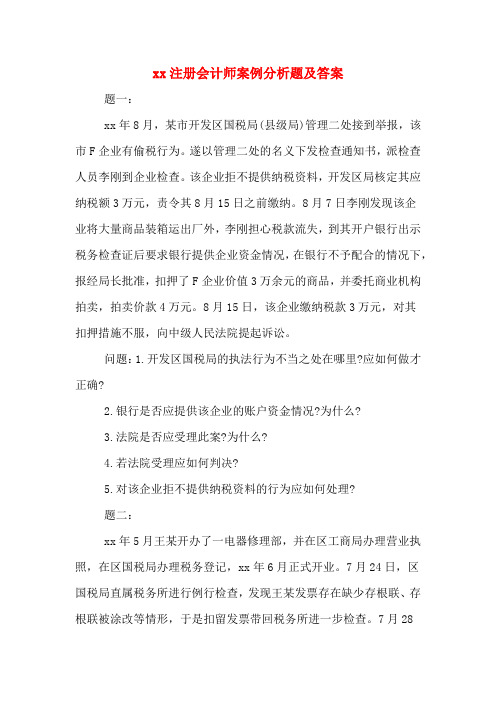
xx注册会计师案例分析题及答案题一:xx年8月,某市开发区国税局(县级局)管理二处接到举报,该市F企业有偷税行为。
遂以管理二处的名义下发检查通知书,派检查人员李刚到企业检查。
该企业拒不提供纳税资料,开发区局核定其应纳税额3万元,责令其8月15日之前缴纳。
8月7日李刚发现该企业将大量商品装箱运出厂外,李刚担心税款流失,到其开户银行出示税务检查证后要求银行提供企业资金情况,在银行不予配合的情况下,报经局长批准,扣押了F企业价值3万余元的商品,并委托商业机构拍卖,拍卖价款4万元。
8月15日,该企业缴纳税款3万元,对其扣押措施不服,向中级人民法院提起诉讼。
问题:1.开发区国税局的执法行为不当之处在哪里?应如何做才正确?2.银行是否应提供该企业的账户资金情况?为什么?3.法院是否应受理此案?为什么?4.若法院受理应如何判决?5.对该企业拒不提供纳税资料的行为应如何处理?题二:xx年5月王某开办了一电器修理部,并在区工商局办理营业执照,在区国税局办理税务登记,xx年6月正式开业。
7月24日,区国税局直属税务所进行例行检查,发现王某发票存在缺少存根联、存根联被涂改等情形,于是扣留发票带回税务所进一步检查。
7月28日,该税务所根据其自行制定的《发票管理办法》做出处理决定:责令其改正违法行为,处以罚款3000元。
王某不服,以发票存根联被其儿子撕毁、乱画、但并未偷税为由,8月4日向市国税局申请复议。
市国税局接到其递交的复议申请后,认为税务所有执法权,因此,应由其直接的上一级国税局受理复议。
8月10日市国税局以自己无管辖权为由,裁定不予受理。
问题:1.本案中市国税局接到复议申请后的处理是否合法?为什么?2.若你是复议机关,你认为此案应如何做出复议决定?【参考答案】题一解答:1.(1)开发区国税局不应以管理二处的名义下发检查通知书,没有执法主体资格,应以开发区局的名义下发;(2)李刚应出示税务检查证;(3)稽查人员应至少两个人,不应单人稽查;(4)采取税收保全措施之前应先责令企业提供纳税担保;(5)未到纳税限期之前不应拍卖商品抵税;且拍卖应委托依法成立的拍卖机构拍卖,而不应委托商业企业拍卖。
注会案例试题及答案
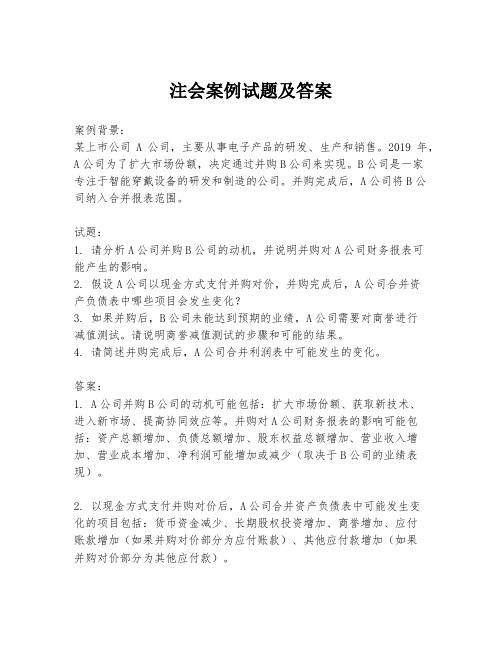
注会案例试题及答案案例背景:某上市公司A公司,主要从事电子产品的研发、生产和销售。
2019年,A公司为了扩大市场份额,决定通过并购B公司来实现。
B公司是一家专注于智能穿戴设备的研发和制造的公司。
并购完成后,A公司将B公司纳入合并报表范围。
试题:1. 请分析A公司并购B公司的动机,并说明并购对A公司财务报表可能产生的影响。
2. 假设A公司以现金方式支付并购对价,并购完成后,A公司合并资产负债表中哪些项目会发生变化?3. 如果并购后,B公司未能达到预期的业绩,A公司需要对商誉进行减值测试。
请说明商誉减值测试的步骤和可能的结果。
4. 请简述并购完成后,A公司合并利润表中可能发生的变化。
答案:1. A公司并购B公司的动机可能包括:扩大市场份额、获取新技术、进入新市场、提高协同效应等。
并购对A公司财务报表的影响可能包括:资产总额增加、负债总额增加、股东权益总额增加、营业收入增加、营业成本增加、净利润可能增加或减少(取决于B公司的业绩表现)。
2. 以现金方式支付并购对价后,A公司合并资产负债表中可能发生变化的项目包括:货币资金减少、长期股权投资增加、商誉增加、应付账款增加(如果并购对价部分为应付账款)、其他应付款增加(如果并购对价部分为其他应付款)。
3. 商誉减值测试的步骤包括:首先,确定商誉所在的现金产生单元;其次,对现金产生单元进行公允价值评估;然后,比较现金产生单元的账面价值与公允价值;最后,如果账面价值高于公允价值,则需要计提减值损失。
可能的结果包括:无需计提减值损失、计提部分减值损失、计提全部减值损失。
4. 并购完成后,A公司合并利润表中可能发生的变化包括:营业收入增加(B公司的销售收入)、营业成本增加(B公司的产品成本)、销售费用增加(B公司的销售费用)、管理费用增加(B公司的管理费用)、财务费用可能增加或减少(取决于并购融资方式)、净利润可能增加或减少(取决于B公司的业绩表现)。
香港CPA案例分析大赛题目与答案示例

Company mission and values
KEC's mission statement is as follows: KEC places the 21st century global consumer first. A safe, affordable and reliable vehicle meeting customer's driving needs – and the needs of future generations. Company values are as follows:
Mini-van Sedan Other vehicles Automotive parts and components Total
Revenue (RMB mil) 3,393 3,110 280
Revenue (RMB mil) 2,919 2,508 195
109,860
518 7,301
7.1 100.0
Mini-van sales பைடு நூலகம்ncreased 16% from 2009 to 2010, but dropped to 46.5% of overall revenue in 2010.
Sedan
KEC is one of the dominant producers in the sedan market and holds about 15% of the market. KEC released a new model of its premier brand during the year, the 'Honey Bee', and this was well received by the PRC market. Sedan sales increased 24% from 2009 to 2010, but were at a lower overall revenue compared to previous year.
2020年注会综合阶段考试试题及答案:案例题
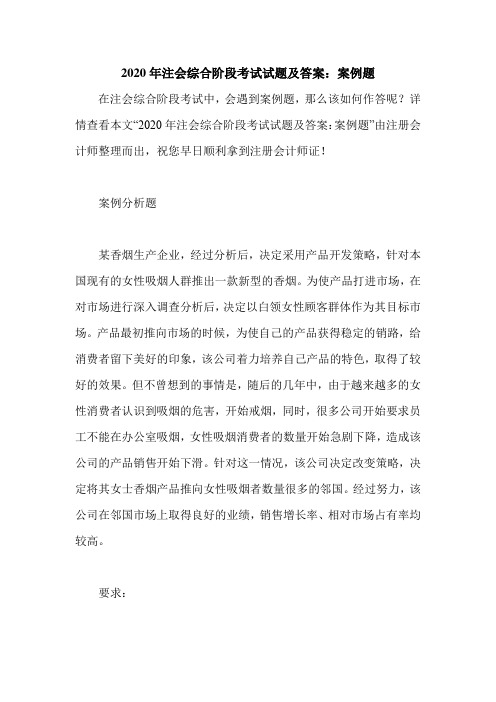
2020年注会综合阶段考试试题及答案:案例题在注会综合阶段考试中,会遇到案例题,那么该如何作答呢?详情查看本文“2020年注会综合阶段考试试题及答案:案例题”由注册会计师整理而出,祝您早日顺利拿到注册会计师证!案例分析题某香烟生产企业,经过分析后,决定采用产品开发策略,针对本国现有的女性吸烟人群推出一款新型的香烟。
为使产品打进市场,在对市场进行深入调查分析后,决定以白领女性顾客群体作为其目标市场。
产品最初推向市场的时候,为使自己的产品获得稳定的销路,给消费者留下美好的印象,该公司着力培养自己产品的特色,取得了较好的效果。
但不曾想到的事情是,随后的几年中,由于越来越多的女性消费者认识到吸烟的危害,开始戒烟,同时,很多公司开始要求员工不能在办公室吸烟,女性吸烟消费者的数量开始急剧下降,造成该公司的产品销售开始下滑。
针对这一情况,该公司决定改变策略,决定将其女士香烟产品推向女性吸烟者数量很多的邻国。
经过努力,该公司在邻国市场上取得良好的业绩,销售增长率、相对市场占有率均较高。
要求:(1)简述战略失效的三种类型,并说明该公司在本国市场上的战略失效属于什么类型?(2)简述选择战略变革的时机的三种类型,并确定该公司战略变革时机的所属类型(3)根据波士顿矩阵法,该公司产品在邻国市场上属于什么类型的产品?『正确答案』(1)按照在战略实施过程中出现的时间顺序,战略失效可分为早期失效、偶然失效和晚期失效三种类型。
在战略实施初期,由于新战略还没有被全体员工理解和接受,或者战略实施者对新的环境、工作还不适应,就有可能导致较高的早期失效率。
晚期失效是指当战略推进一段时间之后,之前对战略环境条件的预测与现实变化发展的情况之间的差距会随着时间的推移变得越来越大,战略所依赖的基础就显得越来越糟,从而使失效率大为提高。
在战略实施过程中,偶然会因为一些意想不到的因素导致战略失效,这就是偶然失效。
由于该公司推出新型香烟后,最初销售状况良好。
高级会计师《案例分析》模拟试题及答案

高级会计师《案例分析》模拟试题及答案高级会计师《案例分析》模拟试题及答案2017案例分析题一1、S集团公司拥有甲上市公司75%的表决权股份。
甲公司是一家从事石油化工生产的公司,分别在上海证券交易所和中国香港联交所上市。
(1)甲公司2×13年进行了一系列重大的资本运作和机构调整,以期优化企业的产业结构、提高企业的核心竞争力。
甲公司2×13年发生的相关事项如下:①2×13年5月18日,为拓展境外销售渠道,甲公司与乙公司签订合同,以45亿港元的价格收购乙公司的全资子公司F公司的全部股权,使F公司成为甲公司的全资子公司。
F公司主要从事中国香港地区的26个加油(气)站和2个油库的经营业务。
2×13年4月30日,F公司的账面净资产为26亿港元。
2×13年5月28日,甲公司向乙公司支付了收购价款45亿港元。
2×13年7月1日办理完毕F公司股权转让手续。
收购前,甲公司与乙公司、F公司均不存在关联方关系。
②2×13年7月3日,甲公司以现金收购了S集团公司所属G公司拥有的油田开采业务,G公司为S集团公司的全资子公司。
2×13年6月30日,G公司拥有的油田开采业务资产账面价值为26亿元;国内资产评估机构以2×13年6月30日为基准日,对G公司拥有的油田开采资产进行评估所确认的价值为30亿元。
甲公司与G公司签订的收购合同规定,收购G公司拥有的油田开采业务的价款为35亿元。
2×13年8月28日,甲公司向G公司支付了全部价款,并于2×13年10月1日办理完毕G公司油田开采业务产权转让手续。
(2)2×13年1月1日,甲公司与下列公司的关系及有关情况如下:①A公司。
A公司系S集团财务公司,主要负责S集团所属单位和甲公司及其子公司内部资金结算、资金筹措和运用等业务,注册资本60亿元。
甲公司拥有A公司49%的有表决权股份,S集团直接拥有A公司51%的有表决权股份。
2016注册会计师综合阶段考试案例分析题及答案解析【3】
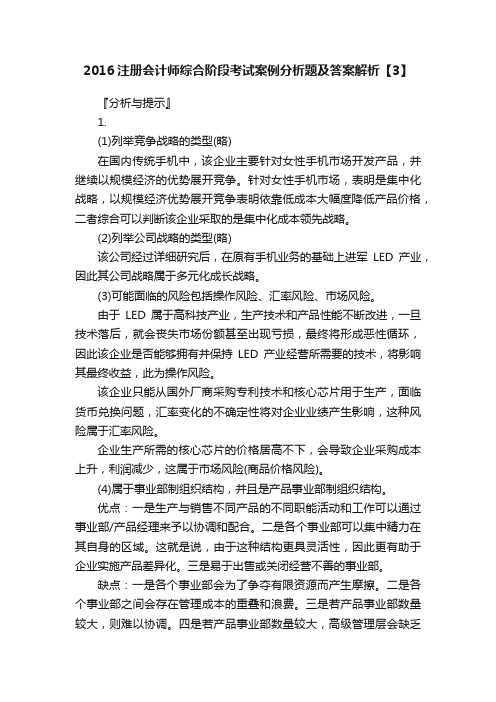
2016注册会计师综合阶段考试案例分析题及答案解析【3】『分析与提示』1.(1)列举竞争战略的类型(略)在国内传统手机中,该企业主要针对女性手机市场开发产品,并继续以规模经济的优势展开竞争。
针对女性手机市场,表明是集中化战略,以规模经济优势展开竞争表明依靠低成本大幅度降低产品价格,二者综合可以判断该企业采取的是集中化成本领先战略。
(2)列举公司战略的类型(略)该公司经过详细研究后,在原有手机业务的基础上进军LED产业,因此其公司战略属于多元化成长战略。
(3)可能面临的风险包括操作风险、汇率风险、市场风险。
由于LED属于高科技产业,生产技术和产品性能不断改进,一旦技术落后,就会丧失市场份额甚至出现亏损,最终将形成恶性循环,因此该企业是否能够拥有并保持LED产业经营所需要的技术,将影响其最终收益,此为操作风险。
该企业只能从国外厂商采购专利技术和核心芯片用于生产,面临货币兑换问题,汇率变化的不确定性将对企业业绩产生影响,这种风险属于汇率风险。
企业生产所需的核心芯片的价格居高不下,会导致企业采购成本上升,利润减少,这属于市场风险(商品价格风险)。
(4)属于事业部制组织结构,并且是产品事业部制组织结构。
优点:一是生产与销售不同产品的不同职能活动和工作可以通过事业部/产品经理来予以协调和配合。
二是各个事业部可以集中精力在其自身的区域。
这就是说,由于这种结构更具灵活性,因此更有助于企业实施产品差异化。
三是易于出售或关闭经营不善的事业部。
缺点:一是各个事业部会为了争夺有限资源而产生摩擦。
二是各个事业部之间会存在管理成本的重叠和浪费。
三是若产品事业部数量较大,则难以协调。
四是若产品事业部数量较大,高级管理层会缺乏整体观念。
2.(1)东方公司设立方案的不合法之处:甲、乙公司出资金额不符合法律规定。
理由:公司法律规定,以募集设立方式设立股份有限公司的,发起人认购的股份不得少于公司股份总数的百分之三十五,甲乙公司作为发起人,出资额不得少于2100万元(6000×35%),而方案中发起人的出资额只有2000万元,不符合规定。
香港注册会计师考师审计笔记试卷答案cjun2003a
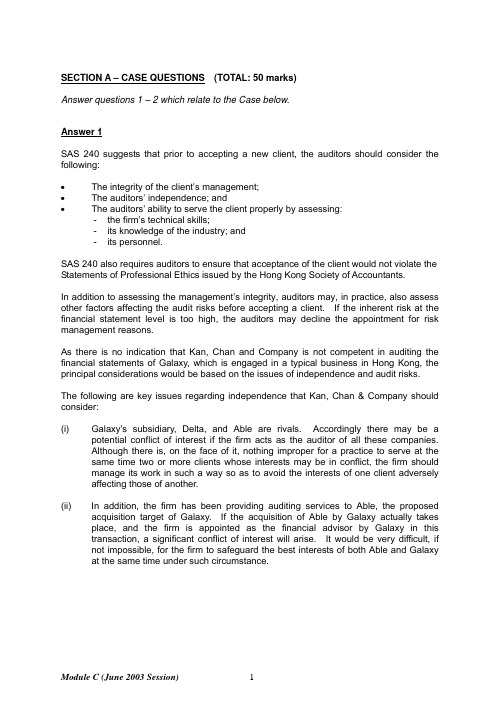
SECTION A – CASE QUESTIONS (TOTAL: 50 marks)Answer questions 1 – 2 which relate to the Case below.Answer 1SAS 240 suggests that prior to accepting a new client, the auditors should consider the following:•The integrity of the client’s management;•The auditors’ independence; and•The auditors’ ability to serve the client properly by assessing:- the firm’s technical skills;- its knowledge of the industry; and- its personnel.SAS 240 also requires auditors to ensure that acceptance of the client would not violate the Statements of Professional Ethics issued by the Hong Kong Society of Accountants.In addition to assessing the management’s integrity, auditors may, in practice, also assess other factors affecting the audit risks before accepting a client. If the inherent risk at the financial statement level is too high, the auditors may decline the appointment for risk management reasons.As there is no indication that Kan, Chan and Company is not competent in auditing the financial statements of Galaxy, which is engaged in a typical business in Hong Kong, the principal considerations would be based on the issues of independence and audit risks.The following are key issues regarding independence that Kan, Chan & Company should consider:(i) Galaxy’s subsidiary, Delta, and Able are rivals. Accordingly there may be apotential conflict of interest if the firm acts as the auditor of all these companies.Although there is, on the face of it, nothing improper for a practice to serve at the same time two or more clients whose interests may be in conflict, the firm should manage its work in such a way so as to avoid the interests of one client adversely affecting those of another.(ii) In addition, the firm has been providing auditing services to Able, the proposed acquisition target of Galaxy. If the acquisition of Able by Galaxy actually takes place, and the firm is appointed as the financial advisor by Galaxy in this transaction, a significant conflict of interest will arise. It would be very difficult, if not impossible, for the firm to safeguard the best interests of both Able and Galaxy at the same time under such circumstance.(iii) Assuming that the audit fee for Galaxy for the current year remains at the level of HK$400,000, which is assumed to be realistic and reasonable, and that Galaxy successfully acquires Able, the total recurring audit fees received from the Galaxy group will be in the region of HK$900,000. As such recurring fees derived from one client or group of connected clients exceed 10% of the firm’s gross fees, undue dependence on fees received from a single client may arise. Under such circumstances, the firm’s independence and objectivity are potentially at risk.(iv) In addition, the special fees from the one-off assignment of conducting additional work on Galaxy’s inventories and acting as the financial advisor of Galaxy in the acquisition of Able, could, if taken together with the recurring audit work, aggravate the problem of undue dependence on an audit client. Samuel’s indication that the firm may be able to keep the audit of Able may again create further potential impairment to the firm’s objectivity and independence.(v) The ethical guidelines view the charging of fees on a percentage, contingency or similar basis as a threat to objectivity to members in practice, and therefore prohibit practice units from adopting such methods of charging in respect of audit work or reporting assignments incorporating professional opinions. Samuel’s offer to double the audit fees for future audits of the Galaxy group after it is successfully listed may fall within these restrictions, unless the increase in fee reflects the additional work done for a listed client.(vi) However, the ethical guidelines expressly allow fees to be charged on a contingency basis for certain work, such as advising on a management buy-out, the raising of venture capital, acquisitions search or sales mandates, etc., provided that such basis of charging is adopted after careful consideration. Hence, even if the firm has properly and successfully addressed the issues of conflict of interest and of undue dependence on the Galaxy group, it would still need to give due considerations to a number of other areas, including, inter alia, the seniority and expertise of the persons engaged on the work; the estimated time to be incurred;the degree of risk and responsibility required; the complexity of the engagement;and the priority and importance of the work to Galaxy.(vii) The potential close personal relationship between Cecil Kan and Samuel Choi through Ruth may create a familiarity threat, which could in turn affect the objectivity of the firm.The following are key issues regarding management’s integrity and the risks that Kan, Chan & Company should consider:(i) Galaxy is planning to list on the Hong Kong Stock Exchange. This will increase thepublic profile of the company. Many investors, potential or existing, will use the company’s audited financial statements in making their investment decisions.(ii) As Galaxy is planning to list, the management is facing pressure to meet the listing requirements with respect to the group’s finances of the group such as demonstrating a minimum profit level, even though the company has a proven track record of profits.(iii) The management of Galaxy’s insistence on receiving unqualified audit reports for the purpose of obtaining a listing and offer to double the audit fee if the group gets listed may cast doubt on management’s integrity.(iv) The reasons for the change of auditor deserve concern. Although it is indisputable that the client has the right to choose its own auditor, the firm should endeavour to ascertain the reasons for the proposed change. This is of particular importance in view of the sudden resignation of the previous auditor shortly before the financial year end.(v) The recent resignation of the previous CFO also deserve concern because of its timing in relation to the sudden resignation of the previous auditors. If Samuel as the newly appointed CFO is not experienced and competent enough to take over the work, the possibility of errors occurring in the financial statements becomes higher.Possible courses of action to be adopted by the firm in addressing the issues relating to independence include:(i) Different audit teams (and preferably different engaging partners) should bedeployed for the audits of Galaxy, Delta, and Able so as to maintain the firm’s independence.(ii) Before accepting the engagement as Galaxy’s financial advisor, the firm should seek to inform Galaxy and Able about its work performed for the other parties and obtain the consent of both in writing. If such written consent is not available, the firm should consider declining this appointment.(iii) Although the total amount of fees derived from the Galaxy group has not yet exceeded the HKSA’s stipulated threshold of 15% of the firm’s gross fees, the firm should begin to closely monitor its position so as to avoid any possible non-compliance with HKSA’s requirements.(iv) Even if the firm successfully resolves the conflict of interest issue relating to its accepting the advisory work for Galaxy’s intended take-over of Able, it should make clear in any document prepared by it, the capacity in which the firm has worked and the basis of its remuneration in contemplation that a third party may rely on this information.(v) Cecil Kan should refrain from being involved in the audit of the Galaxy group in case Samuel Choi becomes his son in law.(vi) The firm should regularly review the situation, preferably by a senior partner not personally involved with the engagements relating to Galaxy, Delta and Able.Possible courses of action to be adopted by the firm in addressing the issues regarding integrity of the management and risks include:(i) The auditors’ assessment of the management’s integrity affects their assessment ofthe inherent risks at the financial statement level as well as the control environment.If the auditors have doubts about the management’s integrity and consider there are significant audit risks, the auditors should adopt an audit approach that relies more on substantive procedures.(ii) There is an inverse relationship between materiality and the level of audit risk, that is, the higher the audit risk, the lower the materiality level (i.e. the auditors accept a lower dollar amount of error). To give a higher level of comfort in this case when the auditors consider the risk is high, the auditors may intentionally set the planning materiality level at a lower level than is intended to be used to evaluate the results of the audit. This may be done to reduce the likelihood of undiscovered misstatements and to provide the auditors with a margin of safety when evaluating the effect of misstatements discovered during the audit. This will ultimately affect the extent of the audit work performed.Answer 2If it is not practicable to attend to physical inventory at the balance sheet date, it is acceptable under SAS 401 to apply alternative procedures provided that such alternative procedures can yield sufficient appropriate audit evidence of existence and condition of the inventory to enable the auditors to conclude that they need not make reference to a scope limitation in the auditors’ report in accordance with SAS 600 “Auditors’ reports on financial statements”.Such alternative procedures may include taking or observing some physical counts on an alternative date and testing intervening transactions to the period end. If the nature of work in progress is such that its existence cannot be verified by a physical count then alternative procedures may include examining supporting costing records, work tickets, evidence of purchases and sales and testing of the internal controls as well as physical inspection.As inventory is material to Galaxy’s financial statements, the firm should obtain sufficient appropriate audit evidence regarding its existence and condition. Based on the information available, an inventory “rollback exercise”, which consists of the attendance of a physical inventory count on a date later than the balance sheet date together with other analytical and reconciling procedures on the inventory movements, appears to be the most feasible solution to this problem. The firm could adopt the following audit procedures to determine the physical existence of Galaxy’s inventories:(i) Ascertain that Galaxy’s records of inventory movements in the intervening periodcan be readily examined and substantiated. A physical inventory count carried out after the year end could only be possible if such records are available and found to be reliable.(ii) If the answer to (i) above is affirmative, arrange with Galaxy to conduct a physical inventory count as soon as possible. The greater the interval between the balance sheet date and the physical count date, the more difficult the inventory rollback exercise will be.(iii) Explain to the client and make them fully understand that acceptability of the results of such an inventory rollback exercise will be highly dependent on the soundness of internal control system, in particular on inventories, and satisfactory maintenance of inventory records.(iv) In planning attendance at the physical inventory count or the alternative procedures, the matters set out below need to be considered:•The materiality of inventory.•The nature of the inventory, for example, whether it comprises work in progress.•The nature of the accounting and internal control systems used regarding inventory.•Inherent, control and detection risks related to the inventory.•Whether adequate procedures are expected to be established and proper instructions issued for physical inventory taking.•The timing of the count.•The locations at which inventory is held.•Whether an expert’s assistance is needed.(v) Review management’s instructions regarding:•The application of control procedures, for example, collection of used inventory sheets, accounting for unused inventory sheets and count andre-count procedures;•Accurate identification of the stage of completion of work in progress, of slow moving, obsolete or damaged items and of inventory owned by a third party,for example, on consignment; and•Whether appropriate arrangements are made regarding the movement of inventory between areas and(vi) Perform test counts on both the completeness and the accuracy of the count records by tracing items selected from those records to the physical inventory and items selected from the physical inventory to the count records. Obtain copies of such count records for subsequent testing and comparison.(vii) Note details of the movement of inventory just prior to, during and after the count so that the accounting for such movements can be checked at a later date.(viii) After the physical count, analyse and reconcile the balance per the physically counted inventories to inventories per the balance sheet by:•reviewing and analysing the inventory control accounts in the general ledger from the physical count date to the balance sheet date; trace additions tosources such as the purchase journal or voucher register, the costaccounting records, and charges to cost of sales, etc.•comparing the current activity between the physical count date and the balance sheet date to activity of the equivalent period in the preceding year.Investigate unusual fluctuations.(ix) Review the sales records and investigate the authenticity of any unusually large sales made in the period prior to the inventory count date.(x) Determine whether any inventory is pledged as collateral or subject to any liens;coordinate with work on debt payable.(xi) Inspect the open purchase order file at the balance sheet date for significant commitments that should be considered for disclosure.(xii) Assess the overall results of the inventory rollback exercise and conclude whether they provide satisfactory evidence as to the physical existence and conditions of Galaxy’s inventories as at the balance sheet date.* * * END OF SECTION A * * *(ANSWERS)SECTION B – ESSAY / SHORT QUESTIONS (Total: 50 marks)Answer ALL of the following questions.Answer 1(a)In order to avoid giving a false impression, auditors should adhere to the professional standards of ethics laid down by the HKSA. Given Statement of Professional Ethics 1.203 “Integrity, Objectivity and Independence” for each professional assignment they undertake, auditors must be, and must be seen to be, free of any interests which might detract from their objectivity.More specifically, in order to demonstrate their objectivity and independence, auditors should avoid:•Undue dependence on fees received from a single client or a group of connected clients;•Close personal and business relationships that can affect objectivity;•Financial involvement with or in the affairs of a client which may affect or may be seen to affect objectivity;•Accepting goods, services or hospitality from an audit client;•Giving a loan to or receiving a loan from an audit client;•Providing services to a client which involve performing management functions or taking management decisions;•Charging and receiving fees for additional services which are disproportionately higher than the audit fee.Auditors should also:•Regularly report to the independent directors, including the audit committee. •Consider reporting to the members as a whole rather than to officers of the company, which is a statutory requirement in Hong Kong.Answer 1(b)It is critical that auditors are seen as independent of their audit clients, their client’s management and other influences that might impair their objectivity and impartiality. If this perception of objectivity does not prevail, the financial statements inspected by the auditors will lack credibility to those who use and rely on them and the audit will be of little or no value.Answer 2(a)[Date]Mr. A.B. ChanChief AccountantDEF Retail Shop Limited123 Queens RoadHong KongDear Mr. ChanI refer to our recent discussion in connection with your company’s decision to replace your existing computer system which has been in use for the past 15 years. When undertaking such a task you need to consider a number of important issues which I outline below.System conversion methodsThere are various options that can be adopted when converting to a new system. The options include:(1) “Big bang approach”This relates to when the new system is implemented all at once. This approach carries with it some additional risks, particularly if the system is of a large size and covers a large number of users.approach(2) PhasedThis could relate to implementation of a particular module first, a group of integrated modules or one complete business cycle. It generally involves less effort than the “big bang approach” and is more manageable.system(3) PilotThis basically relates to the implementation at one location prior to any system roll out to the wider user base. This pilot could be of the complete system or of one phase of the implementation. This method is usually accepted when the organization wants to reduce the risk of implementation. The pilot is generally carried out at a small site that is representative of the whole organization so as, to identify any problems and address these prior to implementation in the wider context.operation(4) ParallelThis relates to a decision to implement the new system in parallel to the system that it is replacing for a period of time. This provides the opportunity to confirm the results of the new system by comparing them to the output from the existing system.It may also be used to resolve any procedural problems or policy changes.However, this method generally involves additional workload and operating costs. Answer 2(b)Reliability of the new systemTo ensure reliability of the new system you need to:(1) Test the new system to make sure that it will do what it is expected to do;(2) Maintain the integrity of all existing data files during the conversion process;(3) Complete validation and balancing procedures of all data files before converting tothe new system;(4) Ensure that the audit trail continues to exist and function throughout the conversionactivities, that is during the planning for and implementation of the system conversion; and(5) Provide personnel training for the system conversion as the effectiveness of such aconversion will depend on training being well planned, funded and delivered.I believe the above clarify the situation. Should you like to discuss this matter further, please let me know.Yours sincerely,John WongAnswer 3(a)As the manager in charge of the audit, I would point out the following to the company’s finance director:•SAS 402 requires that auditors should send bank confirmation requests when the entity’s banking activities, including treasury operations, are significant to the audit.•It is mandatory to send bank confirmation requests unless a company’s banking activities are not significant, which is not likely for a listed company.•SAS 402 also requires that when the auditors seek to confirm certain balances externally or other information externally, and management requests the auditors not to do so, the auditors should consider whether there are valid grounds for sucha request and obtain evidence to support the validity of management’s requests.• A request to complete the audit earlier than previously agreed is not valid grounds for not sending out confirmation requests.•If management prevent auditors from carrying out external confirmations, this will constitute a limitation on the scope of work performed and the impact of such actions on the auditors’ report needs to be considered.When considering the reasons provided by management, we apply an attitude of professional skepticism and consider whether the request has any implications regarding management’s integrity.We also need to consider whether management’s request may indicate the possible existence of fraud or error, and whether alterative procedures will provide sufficient appropriate audit evidence.If we agree to management’s request not to seek bank confirmations, we should apply alternative procedures to obtain sufficient appropriate audit evidence.Answer 3(b)The reliability of each of the suggested alternative procedures as an auditing procedure is assessed as follows:•Bank statements on hand are documentary audit evidence created by third parties and held by the reporting entity. They are subject to possible alterations by the reporting entity and therefore their reliability is considered as only moderate.•When performing external confirmation procedures, the auditors should maintain control over the process of, inter alias, sending of external confirmation requests, and the responses to those requests. Accordingly, it is not acceptable to allow the reporting entity’s staff to take the confirmation requests to the bank.•The bank confirmation requests should be sent out on a standard blank form so that all relevant information regarding outstanding balances and transactions as of a particular date can be reported to the auditors. This is to ensure completeness of the information as reported in the reporting entity’s accounting records. •Representations by management cannot be accepted as a substitute for other audit evidence that the auditors could reasonably expect to be available. Accordingly, the auditors should not rely solely on directors’ written representations for obtaining sufficient appropriate audit evidence regarding the company’s bank balances and borrowings.Answer 4The education and training that auditors receive and their experience as auditors enable them to be knowledgeable about business matters in general, but auditors do not normally have the expertise of a person such as an actuary, engineer or as in this case a property valuer, trained and qualified to engage in and practice their said profession.If the auditors determine that it is appropriate to use the work of an expert, the auditors may need to obtain, in conjunction with the entity or independently, audit evidence in the form of reports, opinions, valuations and statements of an expert.An example is the valuation of certain types of assets such as residential properties under development as in this case.If the auditors are unable to obtain sufficient appropriate evidence, by relying on the work of HVSL or other experts engaged directly by the auditors, the auditors should consider the implications for their report in accordance with SAS 600.To ensure that HVSL is a suitable candidate to rely on, the auditors need to assess whether HVSL is professionally competent and objective. For this purpose, the firm needs to consider the following:•Are the surveyors involved in the valuation professionally qualified? (Are they qualified members of a professional surveying bodies, like the Royal Institution of Chartered Surveyors or the Hong Kong Institute of Surveyors?)•Do the surveyors involved in the valuation have appropriate experience in the valuation of residential properties under development in Hong Kong?•Does HVSL rely heavily on work (valuation as well as other works normally performed by a firm of surveyors) initiated by the company?•Does HVSL or any of its management or staff have a financial interest in the company?•Does HVSL or any of its management or staff have any close personal relationship with the directors of the company?* * * END OF EXAMINATION PAPER * * *(ANSWERS)Module C (June 2003 Session) 11。
注册会计师考试审计案例分析试题含答案
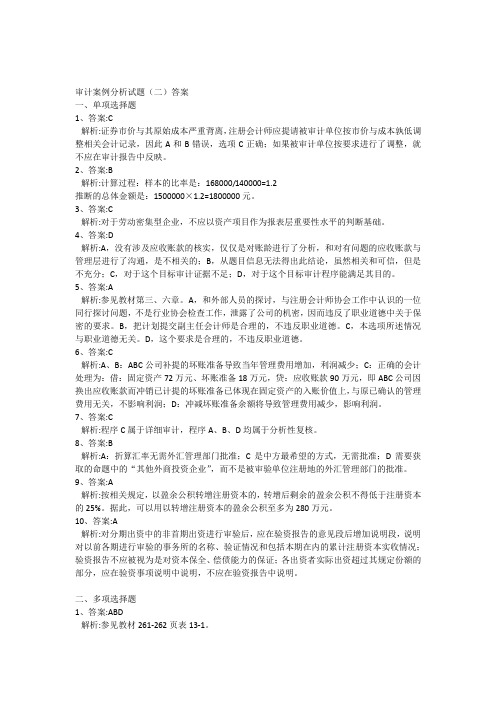
审计案例分析试题(二)答案一、单项选择题1、答案:C解析:证券市价与其原始成本严重背离,注册会计师应提请被审计单位按市价与成本孰低调整相关会计记录,因此A和B错误,选项C正确;如果被审计单位按要求进行了调整,就不应在审计报告中反映。
2、答案:B解析:计算过程:样本的比率是:168000/140000=1.2推断的总体金额是:1500000×1.2=1800000元。
3、答案:C解析:对于劳动密集型企业,不应以资产项目作为报表层重要性水平的判断基础。
4、答案:D解析:A,没有涉及应收账款的核实,仅仅是对账龄进行了分析,和对有问题的应收账款与管理层进行了沟通,是不相关的;B,从题目信息无法得出此结论,虽然相关和可信,但是不充分;C,对于这个目标审计证据不足;D,对于这个目标审计程序能满足其目的。
5、答案:A解析:参见教材第三、六章。
A,和外部人员的探讨,与注册会计师协会工作中认识的一位同行探讨问题,不是行业协会检查工作,泄露了公司的机密,因而违反了职业道德中关于保密的要求。
B,把计划提交副主任会计师是合理的,不违反职业道德。
C,本选项所述情况与职业道德无关。
D,这个要求是合理的,不违反职业道德。
6、答案:C解析:A、B:ABC公司补提的坏账准备导致当年管理费用增加,利润减少;C:正确的会计处理为:借:固定资产72万元、坏账准备18万元,贷:应收账款90万元,即ABC公司因换出应收账款而冲销已计提的坏账准备已体现在固定资产的入账价值上,与原已确认的管理费用无关,不影响利润;D:冲减坏账准备余额将导致管理费用减少,影响利润。
7、答案:C解析:程序C属于详细审计,程序A、B、D均属于分析性复核。
8、答案:B解析:A:折算汇率无需外汇管理部门批准;C是中方最希望的方式,无需批准;D需要获取的命题中的“其他外商投资企业”,而不是被审验单位注册地的外汇管理部门的批准。
9、答案:A解析:按相关规定,以盈余公积转增注册资本的,转增后剩余的盈余公积不得低于注册资本的25%。
香港注册会计师考师审计笔记试卷答案C_May2005A
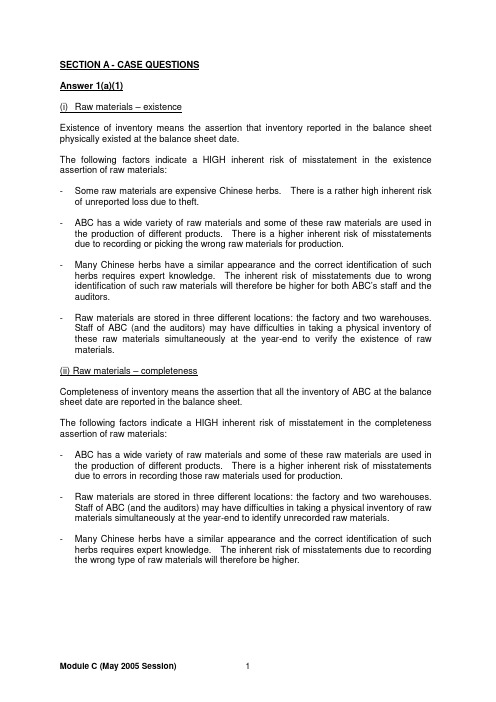
SECTION A - CASE QUESTIONSAnswer 1(a)(1)(i) Raw materials – existenceExistence of inventory means the assertion that inventory reported in the balance sheet physically existed at the balance sheet date.The following factors indicate a HIGH inherent risk of misstatement in the existence assertion of raw materials:- Some raw materials are expensive Chinese herbs. There is a rather high inherent risk of unreported loss due to theft.- ABC has a wide variety of raw materials and some of these raw materials are used in the production of different products. There is a higher inherent risk of misstatements due to recording or picking the wrong raw materials for production.- Many Chinese herbs have a similar appearance and the correct identification of such herbs requires expert knowledge. The inherent risk of misstatements due to wrong identification of such raw materials will therefore be higher for both ABC’s staff and the auditors.- Raw materials are stored in three different locations: the factory and two warehouses.Staff of ABC (and the auditors) may have difficulties in taking a physical inventory of these raw materials simultaneously at the year-end to verify the existence of raw materials.(ii) Raw materials – completenessCompleteness of inventory means the assertion that all the inventory of ABC at the balance sheet date are reported in the balance sheet.The following factors indicate a HIGH inherent risk of misstatement in the completeness assertion of raw materials:- ABC has a wide variety of raw materials and some of these raw materials are used in the production of different products. There is a higher inherent risk of misstatements due to errors in recording those raw materials used for production.- Raw materials are stored in three different locations: the factory and two warehouses.Staff of ABC (and the auditors) may have difficulties in taking a physical inventory of raw materials simultaneously at the year-end to identify unrecorded raw materials.- Many Chinese herbs have a similar appearance and the correct identification of such herbs requires expert knowledge. The inherent risk of misstatements due to recording the wrong type of raw materials will therefore be higher.(iii) Raw materials - valuation and allocationValuation and allocation inventory means the assertion that the carrying amount of inventory of ABC at the balance sheet date are measured accurately in accordance with the relevant accounting standards.The following factors indicate a HIGH inherent risk of misstatement in the valuation and allocation assertion of raw materials:- The correct identification of Chinese herbs requires expert knowledge and herbs with a similar appearance could have significantly different costs. There is a higher inherent risk of misstatements in quantities due to errors in recording or picking raw materials for production, resulting in material misstatements in the valuation and allocation.- Most of the raw materials have long use-by-dates only when they are properly stored.The write-down of raw materials to net realisable value may be necessary even if there are inventory movements during the period.- Although most of these Chinese herbs have long use-by-dates, some herbs may still have a comparatively short expiry period. There is a higher inherent risk of obsolescence for these inventory items.- In addition, the longer these Chinese herbs have been stored, the higher the inherent risk of obsolescence for these inventory items.- As the identification of Chinese herbs requires expert knowledge since many different Chinese herbs with significantly different costs and effects have a similar appearance, the valuation of raw materials relies heavily on the expert. Auditors should obtain sufficient and appropriate audit evidence that this expert work is adequate for the purpose of the audit according to SAS 520. Therefore, the inherent risk is high. Answer 1(a)(2)(i) Work in progress – existenceThe following factors indicate a HIGH inherent risk of misstatement in the existence assertion of work in progress:- Work in progress is contained in sealed vats or sealed mixing containers. ABC’s staff (and the auditors) would not be able to physically observe the existence of the work in progress.- Since production in the GuanXi factory will not stop during the physical inventory taking, ABC’s staff and the auditors may have difficulties in establishing a proper cut-off and the stage of completion of work in progress during the physical inventory taking.(ii) Work in progress – completenessThe following factors indicate a LOW inherent risk of misstatement in the completeness assertion of work in progress:- ABC’s products are manufactured in a single factory and are stored in specific vats or containers, which are likely to be limited in number. The possibility of missing a material amount of work in progress during the physical inventory is comparatively low.(iii) Work in progress – valuation and allocationThe following factors indicate a HIGH inherent risk of misstatement in the valuation and allocation assertion of work in progress:- ABC’s work in progress is carried at standard cost. Cost variances of work in progress would include labour and overhead variances. Year-end adjustments of these variances to approximate the actual inventory cost could be a complicated task. ABC’s accounting personnel are required to have high levels of competency in making correct absorption of these variances into the year-end inventory. Professional judgement will be involved in making these accounting estimates.Answer 1(a)(3)(i) Finished goods – existenceThe following factors indicate a HIGH risk of misstatement in the existence assertion of finished goods:- Finished goods are stored in five different locations: three warehouses in Hong Kong and two in Guanxi. Staff of ABC (and the auditors) may have difficulties in conductinga physical inventory for all these locations simultaneously at the year-end to verify theexistence of finished goods.- Unused warehouse space is leased to customers. Finished goods may have been mixed with customers’ inventory during the physical inventory taking.- In addition, finished goods may be delivered without being recorded.(ii) Finished goods – completenessThe following factors indicate a HIGH inherent risk of misstatement in the completeness assertion of finished goods:- Unused warehouses are leased to customers. Finished goods may have been mixed with customers’ inventory without being counted during the physical inventory.- Finished goods are stored in five different locations: three warehouses in Hong Kong and two in Guanxi. ABC’s staff (and the auditors) may have difficulties in conducting a physical inventory for all these locations simultaneously at the year-end to identify unrecorded finished goods.(iii) Finished goods – valuation and allocationThe following factors indicate a HIGH inherent risk of misstatement in the valuation and allocation assertion of finished goods:- ABC’s finished goods are carried at standard costs. The cost variances of finished goods would include price variance, labour and overhead variances. Year-end adjustments of these variances to approximate the actual inventory cost could be a complicated task.- A write-down of inventory of finished goods of Series X to net realisable value, which involves accounting estimates, is likely since the finished goods have a relatively short use-by-date and the inventory level of certain product lines has increased steadily. ABC’s accounting personnel are required to have a high level of competency in making correct absorption of these variances into the year-end inventory and to determine the appropriate write-down of inventory to its net realisable value. Professional judgement will be involved in making these accounting estimates.Answer 1(b)(i)Valuation and allocation of raw materialsThe specific audit objective is to verify that the carrying amount of ABC’s raw materials at the balance sheet date is measured accurately in accordance with the relevant accounting standards.Since the accuracy of the valuation of raw materials involves expert knowledge (as discussed in 1(a)(1)(iii)), the auditors would normally perform further considerable audit procedures even if they are satisfied with the internal controls.The further audit procedures may include:- obtaining a full list of raw materials and recalculating the total gross amount, probably using CAATs, to consider whether the gross amount matches the amount in the balance sheet.- selecting samples, particularly the expensive ones, from the stock list for ABC’s Chinese herbs experts to confirm that the recorded type or class is the actual type or class.- obtaining, if the auditors considered necessary, independent expert’s confirmation about the type or class of the herbs in the sample that have been obtained in accordance with the procedures set out in SAS 520 Using the Work of an Expert.- enquiring Chinese herbs experts to obtain an understanding of the necessary storage conditions to maintain their use-by-dates, and observation of actual storage conditions to consider whether they match the description.- confirming with ABC’s Chinese herbs experts that they were not aware of any situation during the year in which any material amount of raw materials were not kept under appropriate conditions to maintain their use-by-dates.- inspecting documentary evidence or re-performing any write-down of raw materials to consider whether the write-down complies with relevant accounting standards. The assessment should be conducted in accordance with SAS 420 Audit of Accounting Estimates.- other relevant substantive procedures not listed above.Existence of work in progressThe specific audit objective is to verify that the carrying amount of work in progress reported in the balance sheet physically existed at the balance sheet date.SAS 401 requires that when stock is material to the financial statements, auditors should obtain sufficient appropriate audit evidence regarding its existence and condition by attendance at a physical stocktaking by themselves or another auditor or a suitably qualified person representing them, unless impracticable.Where attendance is impracticable, auditors should consider whether alternative procedures provide sufficient appropriate audit evidence of existence and condition to conclude that auditors need not make reference to a scope limitation.Alternative procedures may include taking or observing physical counts on an alternative date and testing intervening transactions to the period end.Given that work in progress alone represents over 7% (23% x 13,290/42,820) of ABC’s total assets, these general principles should be applied to work in progress.The auditors should attend the physical stocktaking of work in progress even if they are satisfied with ABC’s internal controls over the work in progress.In this case, it is clear that physical taking of the work in progress at the balance sheet date is impracticable since the work in progress is contained in sealed containers.Therefore, it is not practicable for the auditors to obtain sufficient appropriate audit evidence regarding the existence of ABC’s work in progress by attendance at a physical stocktaking. The auditors should perform alternative procedures to provide sufficient appropriate audit evidence of the existence of ABC’s work in progress.These alternative procedures may include:- performing analytical procedures on raw materials input and finished goods output for an appropriate period before and after the balance sheet date to consider whether there are any unusual or unreasonable movements;- observation of the physical existence of a sample of finished goods produced from work in progress as at the balance sheet date;- inspection of the documentary evidence of delivery to customers of a sample of finished goods produced from work in progress as at the balance sheet date;- inspection of quality control reports issued by ABC’s qualified Chinese herbs experts to ensure compliance with quality standards in accordance with the licensing terms, and comparison with the accounting records of the relevant work in progress.Completeness of finished goodsThe specific audit objective is to verify that all finished goods of ABC are reported in the balance sheet.The combined inherent and control risk for completeness of finished goods is likely to be reduced to a reasonably low level if ABC has implemented effective internal controls.Provided that the auditors are satisfied with their tests of controls on ABC’s internal controls relevant to completeness of finished goods, the substantive procedures may be limited to substantive analytical procedures on movements of finished goods during the year and an appropriate period after the balance sheet date.Candidates are free to suggest procedures in addition to the above minimum, e.g. inspection of stock-in and stock-out control documentation, to obtain a higher level or assurance.Answer 1(b)(iv)Valuation of finished goodsThe specific audit objective is to verify that the carrying amount of ABC’s finished goods at the balance sheet date is measured accurately in accordance with the relevant accounting standards.Since the accuracy of the valuation of finished goods involves accounting estimates (as discussed in 1(a)(3)(iii)), the auditors would normally perform further audit procedures even if they are satisfied with the internal controls.The audit procedures may include:- investigating ABC’s inventory accounting policy, particularly that on overhead allocation and cost variances accounting, to consider whether the policy complies with relevant accounting standards.- performing analytical procedures on adjustments made to the finished goods at standard costs to consider whether they are reasonable.- re-performing some overhead cost allocations and cost variance accounting to verify whether the procedures were performed in accordance with ABC’s stated accounting policies.- obtaining or preparing an inventory aging analysis and determining whether any write-down of finished goods to net realisable value is necessary. For this purpose, the auditors may need to:- assess the reasonableness of any established policy/method to estimate a product net realisable value by reference to e.g. a typical time lapse from production to delivery to customer, a typical use-by-date, and their relationships to finished goods valuation.- re-perform or review the procedures in estimating any write-down of finished goods to determine whether the procedures comply with ABC’s stated policy.- ask the management of ABC about any deviations from the policy and assess the reasons put forward by the management of ABC; for example, whether Series X is a new series, whether the actual performance of Series X deviates significantly from ABC’s original plan etc.- enquire the management of ABC about slow moving finished goods after the balance sheet date; for example, whether sales of Series X after the balance sheet date have any positive indications of improvement.Answer 2(a)In accordance with HKSA 220, the engagement partner should consider whether members of the engagement team have complied with ethical requirements.The engagement partner should also form a conclusion on compliance with independence requirements that apply to the audit engagement. In doing so, the engagement partner should:- obtain relevant information from the firm and, where applicable, network firms, to identify and evaluate circumstances and relationships that create threats toindependence;- evaluate information on identified breaches, if any, of the firm’s independence policies and procedures to determine whether they create a threat to independence for the audit engagement;- take appropriate action to eliminate such threats or reduce them to an acceptable level by applying safeguards;- promptly report any failure to resolve the matter to the firm for appropriate action; and- document conclusions on independence and any relevant discussions with the firm that support these conclusions.Answer 2(b)In accordance with HKSQC 1, the firm should establish policies and procedures designed to provide it with reasonable assurance that the firm and its personnel comply with relevant ethical requirements, which are the Hong Kong Institute of CPAs Statements of Professional Ethics/Code of Ethics for Professional Accountants (“the Code”).The Code discusses the familiarity threat to an auditor’s independence. A familiarity threat occurs when, by virtue of a close relationship with an assurance client, its directors, officers or employees, a firm or a member of the assurance team becomes too sympathetic to the client's interests.The Code considers the familiarity threat that may be created by using the same senior personnel on an assurance engagement over a long period of time and the safeguards that might be appropriate to address such a threat.Accordingly, the firm should establish policies and procedures:- setting out criteria for determining the need for safeguards to reduce the familiarity threat to an acceptable level when using the same senior personnel on an assurance engagement over a long period of time; and- for all audits of financial statements of listed entities, requiring the rotation of the engagement partner after a specified period in compliance with the Code.The Code requires the rotation of the lead engagement partner for a listed client after apre-defined period, normally no more than seven years.In the case of ABC, the engagement partner and the engagement manager have been serving ABC since its listing on the Hong Kong Stock Exchange in 1999. It is not likely that, under the guidelines of the Code, a familiarity threat exists.Although it is not required by the Code, the firm may consider rotating the engagement partner in the next year’s audit.* * * END OF SECTION A * * *(ANSWERS)SECTION B - ESSA Y/SHORT QUESTIONSAnswer 3Characteristics of an on-line information systemOn-line computer systems are computer systems that enable users to access data and programs directly through terminal devices. Such systems may comprise mainframe computers, minicomputers or a network of connected personal computers (“PCs”).The most significant characteristics relate to:(1) on-line data entry and validation;(2) on-line access to the system by users;(3) possible lack of visible transaction trail; and(4) potential access to the system by non-users, including programmers and other thirdparties (for example, through e-mail and the Internet).When data are entered on-line, they are usually subject to immediate validation checks. Data failing this validation are not accepted and a message may be displayed on the terminal screen, providing the user with the ability to correct the data and re-enter the valid data immediately.Users may have on-line access to the system that enables them to perform various functions (for example, to enter transactions and to read, change or delete programs and data files through the terminal devices).An on-line computer system may be designed not to provide supporting documents for all transactions entered into the system. Such a system must be able to provide details of the transactions on request or by transaction logs or other means.Programmers may have on-line access to the system that enables them to develop new programs and modify existing programs. Unrestricted access provides the programmer with the potential to make unauthorised changes to programs and obtain unauthorised access to other parts of the system and would represent a serious control weakness.Important security measures for an on-line systemApplications in an on-line environment may have greater exposure to unauthorised access and update.An entity's security infrastructure plays an important part in ensuring the integrity of the information produced.The entity may need to establish suitable general controls to mitigate the risks of viruses, unauthorised access and the potential destruction of audit trails. Hence access controls are particularly important to on-line processing.These controls may include the use of passwords and specialised access control software, such as on-line monitors, that maintain control over the menus, authorisation tables, passwords, files and programs that users are permitted to access, and application controls such as pre-processing authorisation.They may also include physical controls such as the use of key locks on terminal devices, locked computer rooms and inactivity timeouts.There should also be controls over passwords: procedures for the assignment and maintenance of passwords to restrict access to authorised users.System development and maintenance controls are also important. There should be procedures to ensure that controls essential to on-line applications, such as passwords, access controls, on-line data validation and recovery procedures, are included in the system during its development and maintenance, and that controls are also designed to ensure that changes to systems operate as expected and are made in the correct manner. Other important aspects of control in an on-line computer system include programming controls, transaction logs, and firewalls.Answer 4(a)Income statement itemsTurnover and gross profitTurnover for the year 2004 increased from HK$700 million last year to HK$800 million. An increase of 14.3% is noted.Gross profit for the year decreased from HK$100 million last year to HK$80 million, despite a sales increase of 14.3% or HK$100 million during the year.The decrease in unit selling price from HK$14,000 last year to HK$10,000 in 2004 may suggest a net realisable problem on the closing inventory.Taxation for the year was HK$3 million as compared to HK$13 million last year. The decrease in taxation is not in line with the decrease in profit before taxation.The effective tax rate for the year 2004 is 6% compared with 17.8% in 2003.Since the company’s business is in Hong Kong, the effective tax rate of 6% suggests taxation for the year may be understated.Answer 4(b)Balance sheet itemsThe inventories balance increased from HK$20 million at 31 December 2003 to HK$80 million at 31 December 2004. The increase in inventories is much more than the increase in sales during the year.With inventories turnover days increased from 9 days ([(10+20)/2]/600*365) to 25 days ([(20+80)/2]/720*365) in 2004, inventories at year-end may have a valuation problem. Greater emphasis should be placed on the audit of the valuation of year-end inventories.Trade debtors increased from HK$60 million at 31 December 2003 to HK$150 million at 31 December 2004, an increase which is not in line with the increase in sales during the year of only 14.3%. Debtors turnover days increased from 31 days (60/700*365) to 68 days (150/800*365). Prolonged credits offered to customers may indicate unusual risks regarding the assertion of valuation of trade debtors.Trade creditors increased from HK$70 million at 31 December 2003 to HK$150 million at 31 December 2004. Creditors turnover days increased from 42 days (70/610*365) to 70 days (150/780*365). The increase in creditors turnover days may suggest Complex has to delay payment to suppliers to keep sufficient working capital.As identified above, taxation for the year may be understated and hence, tax payable at 31 December 2004 is also understated.Going concernThe net current asset of Complex has decreased from HK$70 million to HK$20 million. This suggests that Complex is experiencing a liquidity problem which may cast doubt on the entity’s going concern. The current ratio decreased from 1.64 at 31 December 2003 to 1.08 at 31 December 2004 and the quick ratio decreased from 1.45 at 31 December 2003 to 0.76 at 31 December 2004.Emphasis should be placed on how the entity addresses the going concern issue. Complex’s cash flow projection should be obtained and discussion should be held with management on the basis of the projection and any plan to improve the liquidity issue identified during the planning process.Answer 5The primary responsibility for the identification and disclosure of related parties and transactions with such parties rests with directors and senior management in accordance with SAS 460.Auditors, however, should perform audit procedures designed to obtain sufficient appropriate audit evidence regarding identification and disclosure by directors and senior management of related parties and the effect of related party transactions that are material to the financial statements.The procedures that my team would perform include the following to:1. Review prior year working papers for names of known related parties.2. Review Huge Profit’s procedures for identification of related parties.3. Enquire of management any affiliation of directors and officers with entities includingcustomers A, B, C and D.4. Review shareholder records to determine principal shareholders of Huge Profit.5. Review minutes of shareholders’ meetings and those of the board of directors andother relevant statutory records such as the register of directors’ interests.6. Consider and note any transactions that appear unusual such as transactions withabnormal terms of trade. This would include enquiries with management as to the unusual high margin and extended credit arising from sales of car accessories to customer A.7. Consider and note any transactions which lack apparent logical business for theiroccurrence. This would include enquiries with management as to why customer B has the same sales office as Huge Profit in Shanghai.8. Consider and note any transactions that have been processed or approved in anon-routine manner. This would include enquiries with management as to why sales contracts of two new customers C and D were approved by the finance director of Huge Profit.9. Obtain from directors and/or senior management written representation of thecompleteness of information provided regarding the identification of related parties;completeness of related parties transactions identified in the accounting records and the adequacy of disclosures in the financial statements.10. Where there is any indication that the circumstances set out in paragraph 7 of SAS460, i.e. those which increase the risk of misstatement beyond that which would ordinarily be expected or indicate that a material misstatement regarding related parties has occurred, the auditors should perform modified, extended or additional procedures as are appropriate in the circumstances. If this is the case and the management refuses to disclose anything to auditors, a company search of customers A, B, C and D may be needed.Answer 6(a)Auditors should obtain an understanding of DCF’s process for determining fair value measurements and disclosures and of the relevant control procedures sufficient to develop an effective audit approach.In obtaining an understanding of DCF’s process for determining fair value, auditors should consider the controls over data and the segregation of duties between those committing DCF to the underlying transaction and those responsible for undertaking the valuations. Auditors should also consider the following:- the expertise and experience of those persons determining the fair value measurement; - significant management assumptions used in determining fair value;- documentation supporting the management assumptions;- integrity of change controls and security procedures for valuation models; and- controls over the consistency, timeliness and reliability of data used in valuation models.。
注册会计师案例分析及答案
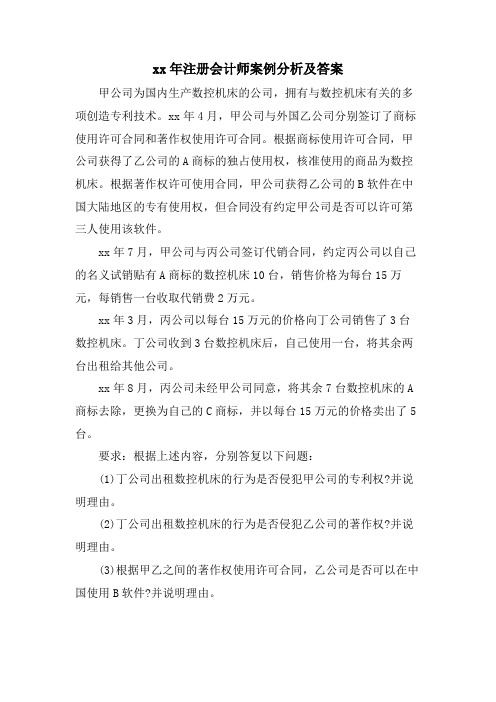
xx年注册会计师案例分析及答案甲公司为国内生产数控机床的公司,拥有与数控机床有关的多项创造专利技术。
xx年4月,甲公司与外国乙公司分别签订了商标使用许可合同和著作权使用许可合同。
根据商标使用许可合同,甲公司获得了乙公司的A商标的独占使用权,核准使用的商品为数控机床。
根据著作权许可使用合同,甲公司获得乙公司的B软件在中国大陆地区的专有使用权,但合同没有约定甲公司是否可以许可第三人使用该软件。
xx年7月,甲公司与丙公司签订代销合同,约定丙公司以自己的名义试销贴有A商标的数控机床10台,销售价格为每台15万元,每销售一台收取代销费2万元。
xx年3月,丙公司以每台15万元的价格向丁公司销售了3台数控机床。
丁公司收到3台数控机床后,自己使用一台,将其余两台出租给其他公司。
xx年8月,丙公司未经甲公司同意,将其余7台数控机床的A 商标去除,更换为自己的C商标,并以每台15万元的价格卖出了5台。
要求:根据上述内容,分别答复以下问题:(1)丁公司出租数控机床的行为是否侵犯甲公司的专利权?并说明理由。
(2)丁公司出租数控机床的行为是否侵犯乙公司的著作权?并说明理由。
(3)根据甲乙之间的著作权使用许可合同,乙公司是否可以在中国使用B软件?并说明理由。
(4)甲公司是否可以许可第三人在中国使用B软件?并说明理由。
(5)丙公司更换A商标的行为是否侵犯乙公司的商标权?并说明理由。
(1)丁公司出租数控机床的行为没有侵犯甲公司的专利权。
根据专利法,当专利权人制造、进口或者经专利权人许可而制造、进口的专利产品或者依照专利方法直接获得的产品售出后,使用,许诺销售或者销售产品的,不视为侵犯专利权。
此题中丁公司从合法的销售渠道购得专利产品之后,可以充分对甲公司的专利产品行使所有权。
(2)丁公司出租数控机床的行为侵犯了乙公司的著作权。
根据法律规定,未经电影作品和以类似方法摄制电影作品的方法创作的作品、计算机软件、录音录像制品的著作权人或者与著作权有关的权利人的许可,出租其作品或者录音录影作品的,应承当侵权责任。
香港注册会计师考试题目

香港注册会计师考试题目摘要:I.引言- 介绍香港注册会计师考试- 说明考试的重要性II.考试科目和范围- 专业阶段考试科目- 综合阶段考试科目- 考试范围III.考试地点和时间- 考试地点- 考试时间IV.报名条件和程序- 报名条件- 报名程序V.备考建议- 学习资料推荐- 备考计划- 模拟试题练习VI.结论- 总结香港注册会计师考试- 强调考试对于职业发展的重要性正文:香港注册会计师考试,也称为HKICPA 考试,是香港会计师公会主办的一项权威性的会计专业考试。
该考试分为专业阶段和综合阶段,考试科目包括会计、审计、财务成本管理、公司战略与风险管理、经济法、税法等。
通过考试的专业人士,将获得香港注册会计师资格,有利于提升个人职业发展,增加就业机会。
专业阶段考试科目包括会计、审计、财务成本管理、公司战略与风险管理、经济法、税法,综合阶段考试科目为职业能力综合测试。
考试范围涵盖了会计、审计、财务管理、企业战略、法律法规等多个方面。
考生在准备考试时,需要全面掌握这些知识领域。
香港注册会计师考试地点在香港、北京、上海、广州、珠海等城市,考试时间一般为每年的4 月和9 月。
考生可以根据自己的实际情况选择考试地点和时间。
报名条件包括具有完全民事行为能力、良好的品行、以及符合香港会计师公会规定的其他条件。
报名程序分为在线报名、资格审核、缴纳报名费等步骤。
考生需要在规定的时间内完成报名,并按照要求提交相关材料。
对于备考香港注册会计师考试,考生可以参考官方教材、专业书籍、网络课程等多种学习资料。
同时,制定合理的备考计划,进行模拟试题练习,以提高自己的应试能力。
总之,香港注册会计师考试对于会计专业人士来说是一项非常重要的考试。
通过考试,不仅可以提升个人的专业素质,还可以为职业发展提供更多的机会。
第五章cpa经济法 案例分析题演练 下载版知识讲解
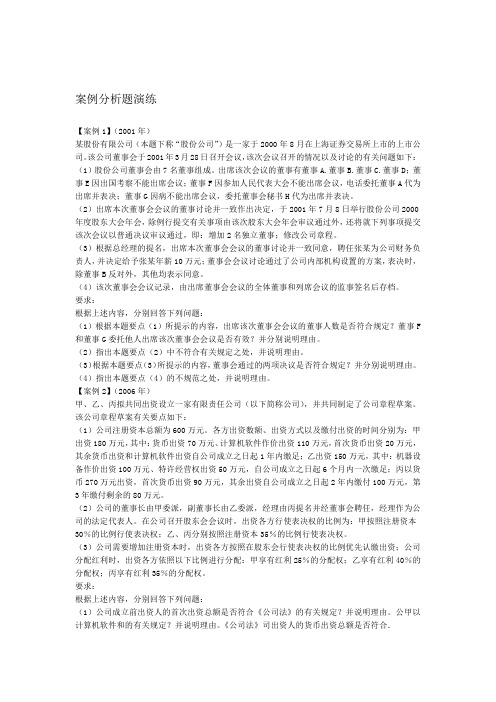
案例分析题演练【案例1】(2001年)某股份有限公司(本题下称“股份公司”)是一家于2000年8月在上海证券交易所上市的上市公司。
该公司董事会于2001年3月28日召开会议,该次会议召开的情况以及讨论的有关问题如下:(1)股份公司董事会由7名董事组成。
出席该次会议的董事有董事A.董事B.董事C.董事D;董事E因出国考察不能出席会议;董事F因参加人民代表大会不能出席会议,电话委托董事A代为出席并表决;董事G因病不能出席会议,委托董事会秘书H代为出席并表决。
(2)出席本次董事会会议的董事讨论并一致作出决定,于2001年7月8日举行股份公司2000年度股东大会年会,除例行提交有关事项由该次股东大会年会审议通过外,还将就下列事项提交该次会议以普通决议审议通过,即:增加2名独立董事;修改公司章程。
(3)根据总经理的提名,出席本次董事会会议的董事讨论并一致同意,聘任张某为公司财务负责人,并决定给予张某年薪10万元;董事会会议讨论通过了公司内部机构设置的方案,表决时,除董事B反对外,其他均表示同意。
(4)该次董事会会议记录,由出席董事会会议的全体董事和列席会议的监事签名后存档。
要求:根据上述内容,分别回答下列问题:(1)根据本题要点(1)所提示的内容,出席该次董事会会议的董事人数是否符合规定?董事F 和董事G委托他人出席该次董事会会议是否有效?并分别说明理由。
(2)指出本题要点(2)中不符合有关规定之处,并说明理由。
(3)根据本题要点(3)所提示的内容,董事会通过的两项决议是否符合规定?并分别说明理由。
(4)指出本题要点(4)的不规范之处,并说明理由。
【案例2】(2006年)甲、乙、丙拟共同出资设立一家有限责任公司(以下简称公司),并共同制定了公司章程草案。
该公司章程草案有关要点如下:(1)公司注册资本总额为600万元。
各方出资数额、出资方式以及缴付出资的时间分别为:甲出资180万元,其中:货币出资70万元、计算机软件作价出资110万元,首次货币出资20万元,其余货币出资和计算机软件出资自公司成立之日起1年内缴足;乙出资150万元,其中:机器设备作价出资100万元、特许经营权出资50万元,自公司成立之日起6个月内一次缴足;丙以货币270万元出资,首次货币出资90万元,其余出资自公司成立之日起2年内缴付100万元,第3年缴付剩余的80万元。
CPA经济法--案例分析题演练--下载版
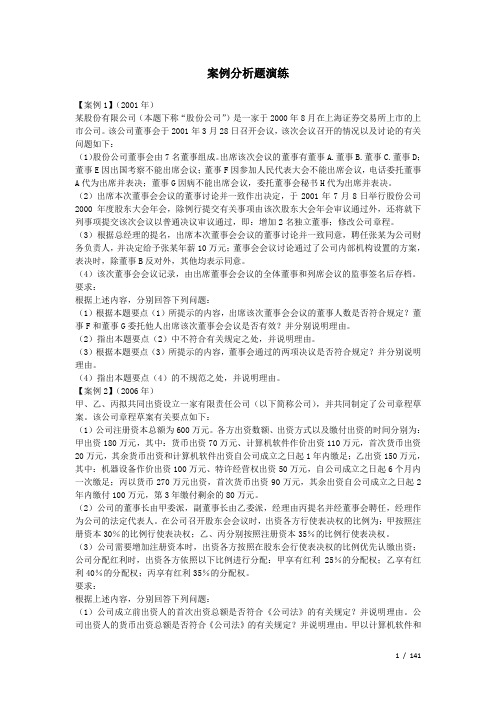
案例分析题演练【案例1】(2001年)某股份有限公司(本题下称“股份公司”)是一家于2000年8月在上海证券交易所上市的上市公司。
该公司董事会于2001年3月28日召开会议,该次会议召开的情况以及讨论的有关问题如下:(1)股份公司董事会由7名董事组成。
出席该次会议的董事有董事A.董事B.董事C.董事D;董事E因出国考察不能出席会议;董事F因参加人民代表大会不能出席会议,电话委托董事A代为出席并表决;董事G因病不能出席会议,委托董事会秘书H代为出席并表决。
(2)出席本次董事会会议的董事讨论并一致作出决定,于2001年7月8日举行股份公司2000年度股东大会年会,除例行提交有关事项由该次股东大会年会审议通过外,还将就下列事项提交该次会议以普通决议审议通过,即:增加2名独立董事;修改公司章程。
(3)根据总经理的提名,出席本次董事会会议的董事讨论并一致同意,聘任张某为公司财务负责人,并决定给予张某年薪10万元;董事会会议讨论通过了公司内部机构设置的方案,表决时,除董事B反对外,其他均表示同意。
(4)该次董事会会议记录,由出席董事会会议的全体董事和列席会议的监事签名后存档。
要求:根据上述内容,分别回答下列问题:(1)根据本题要点(1)所提示的内容,出席该次董事会会议的董事人数是否符合规定?董事F和董事G委托他人出席该次董事会会议是否有效?并分别说明理由。
(2)指出本题要点(2)中不符合有关规定之处,并说明理由。
(3)根据本题要点(3)所提示的内容,董事会通过的两项决议是否符合规定?并分别说明理由。
(4)指出本题要点(4)的不规范之处,并说明理由。
【案例2】(2006年)甲、乙、丙拟共同出资设立一家有限责任公司(以下简称公司),并共同制定了公司章程草案。
该公司章程草案有关要点如下:(1)公司注册资本总额为600万元。
各方出资数额、出资方式以及缴付出资的时间分别为:甲出资180万元,其中:货币出资70万元、计算机软件作价出资110万元,首次货币出资20万元,其余货币出资和计算机软件出资自公司成立之日起1年内缴足;乙出资150万元,其中:机器设备作价出资100万元、特许经营权出资50万元,自公司成立之日起6个月内一次缴足;丙以货币270万元出资,首次货币出资90万元,其余出资自公司成立之日起2年内缴付100万元,第3年缴付剩余的80万元。
2020注册会计师综合阶段考试案例分析题及答案解析
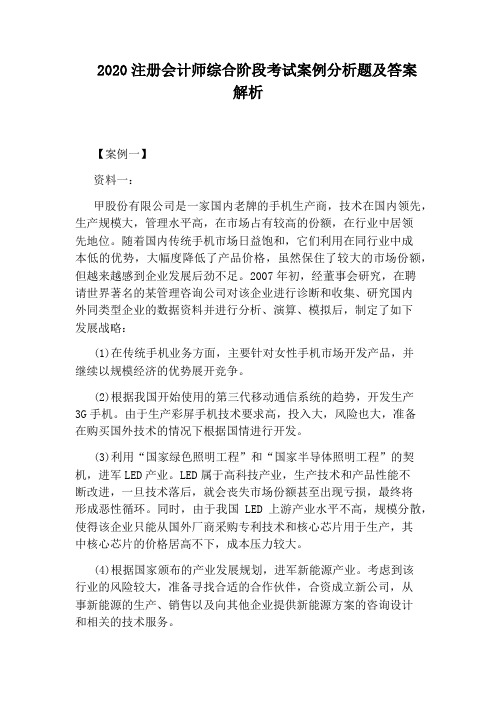
2020注册会计师综合阶段考试案例分析题及答案解析【案例一】资料一:甲股份有限公司是一家国内老牌的手机生产商,技术在国内领先,生产规模大,管理水平高,在市场占有较高的份额,在行业中居领先地位。
随着国内传统手机市场日益饱和,它们利用在同行业中成本低的优势,大幅度降低了产品价格,虽然保住了较大的市场份额,但越来越感到企业发展后劲不足。
2007年初,经董事会研究,在聘请世界著名的某管理咨询公司对该企业进行诊断和收集、研究国内外同类型企业的数据资料并进行分析、演算、模拟后,制定了如下发展战略:(1)在传统手机业务方面,主要针对女性手机市场开发产品,并继续以规模经济的优势展开竞争。
(2)根据我国开始使用的第三代移动通信系统的趋势,开发生产3G手机。
由于生产彩屏手机技术要求高,投入大,风险也大,准备在购买国外技术的情况下根据国情进行开发。
(3)利用“国家绿色照明工程”和“国家半导体照明工程”的契机,进军LED产业。
LED属于高科技产业,生产技术和产品性能不断改进,一旦技术落后,就会丧失市场份额甚至出现亏损,最终将形成恶性循环。
同时,由于我国LED上游产业水平不高,规模分散,使得该企业只能从国外厂商采购专利技术和核心芯片用于生产,其中核心芯片的价格居高不下,成本压力较大。
(4)根据国家颁布的产业发展规划,进军新能源产业。
考虑到该行业的风险较大,准备寻找合适的合作伙伴,合资成立新公司,从事新能源的生产、销售以及向其他企业提供新能源方案的咨询设计和相关的技术服务。
与公司战略调整相适应,组织机构也需要做出调整:拟成立通讯产品、LED照明和新能源三个事业部,分别负责这三大类产品的生产和销售,及其他相关事宜;同时成立一个研究开发部门,统一负责公司的新产品开发和技术创新工作。
资料二:为落实国家产业结构调整政策,加快新能源开发步伐,寻找新的利润增长点,2008年初,甲股份有限公司与乙股份有限公司决定募集设立东方股份有限公司(下称东方公司),有关东方公司的设立和生产经营情况如下:(1)东方公司股本总额为6000万元人民币。
cpa经济法案例分析题
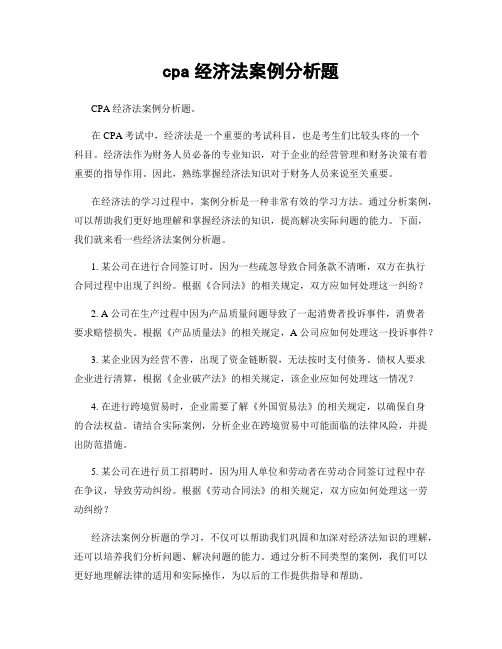
cpa经济法案例分析题CPA经济法案例分析题。
在CPA考试中,经济法是一个重要的考试科目,也是考生们比较头疼的一个科目。
经济法作为财务人员必备的专业知识,对于企业的经营管理和财务决策有着重要的指导作用。
因此,熟练掌握经济法知识对于财务人员来说至关重要。
在经济法的学习过程中,案例分析是一种非常有效的学习方法。
通过分析案例,可以帮助我们更好地理解和掌握经济法的知识,提高解决实际问题的能力。
下面,我们就来看一些经济法案例分析题。
1. 某公司在进行合同签订时,因为一些疏忽导致合同条款不清晰,双方在执行合同过程中出现了纠纷。
根据《合同法》的相关规定,双方应如何处理这一纠纷?2. A 公司在生产过程中因为产品质量问题导致了一起消费者投诉事件,消费者要求赔偿损失。
根据《产品质量法》的相关规定,A 公司应如何处理这一投诉事件?3. 某企业因为经营不善,出现了资金链断裂,无法按时支付债务。
债权人要求企业进行清算,根据《企业破产法》的相关规定,该企业应如何处理这一情况?4. 在进行跨境贸易时,企业需要了解《外国贸易法》的相关规定,以确保自身的合法权益。
请结合实际案例,分析企业在跨境贸易中可能面临的法律风险,并提出防范措施。
5. 某公司在进行员工招聘时,因为用人单位和劳动者在劳动合同签订过程中存在争议,导致劳动纠纷。
根据《劳动合同法》的相关规定,双方应如何处理这一劳动纠纷?经济法案例分析题的学习,不仅可以帮助我们巩固和加深对经济法知识的理解,还可以培养我们分析问题、解决问题的能力。
通过分析不同类型的案例,我们可以更好地理解法律的适用和实际操作,为以后的工作提供指导和帮助。
总之,经济法案例分析题是经济法学习中不可或缺的一部分,希望考生们能够认真对待,多加练习,提高解决实际问题的能力,为将来的工作打下坚实的基础。
希望本文所提供的案例分析题能够对考生们有所帮助,祝大家都能顺利通过 CPA 考试,取得优异的成绩!。
cpa经济法案例分析题
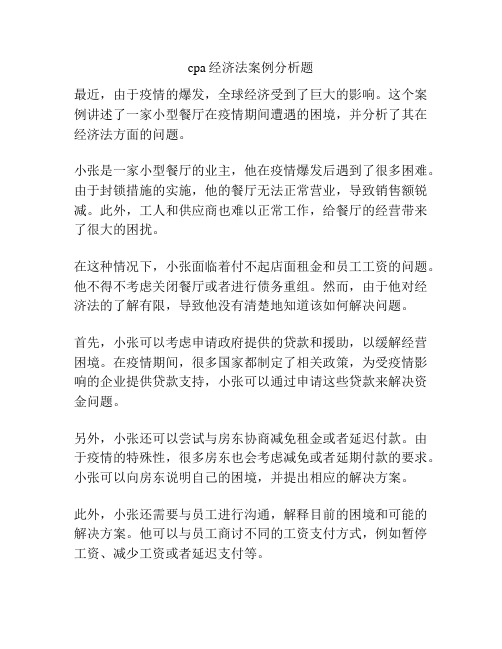
cpa经济法案例分析题最近,由于疫情的爆发,全球经济受到了巨大的影响。
这个案例讲述了一家小型餐厅在疫情期间遭遇的困境,并分析了其在经济法方面的问题。
小张是一家小型餐厅的业主,他在疫情爆发后遇到了很多困难。
由于封锁措施的实施,他的餐厅无法正常营业,导致销售额锐减。
此外,工人和供应商也难以正常工作,给餐厅的经营带来了很大的困扰。
在这种情况下,小张面临着付不起店面租金和员工工资的问题。
他不得不考虑关闭餐厅或者进行债务重组。
然而,由于他对经济法的了解有限,导致他没有清楚地知道该如何解决问题。
首先,小张可以考虑申请政府提供的贷款和援助,以缓解经营困境。
在疫情期间,很多国家都制定了相关政策,为受疫情影响的企业提供贷款支持,小张可以通过申请这些贷款来解决资金问题。
另外,小张还可以尝试与房东协商减免租金或者延迟付款。
由于疫情的特殊性,很多房东也会考虑减免或者延期付款的要求。
小张可以向房东说明自己的困境,并提出相应的解决方案。
此外,小张还需要与员工进行沟通,解释目前的困境和可能的解决方案。
他可以与员工商讨不同的工资支付方式,例如暂停工资、减少工资或者延迟支付等。
同时,小张还需要密切关注政府发布的经济法规定,以了解自己的权利和义务。
在疫情期间,很多国家会出台相关的经济法案,用于保护企业和个人的权益。
小张需要及时了解这些法规,并根据自己的情况进行合理的应对。
总之,小张在面对疫情带来的困境时,需要积极寻求解决方案。
通过申请贷款、与房东协商、与员工沟通以及关注政府经济法规定,小张可以有效应对经济困境,并保护自身的权益。
同时,他也应该尽快加强自己的经济法知识,以便在将来面对类似的情况时能够更好地应对。
注册会计师考试《会计》2023年香港岛点睛提分卷含解析
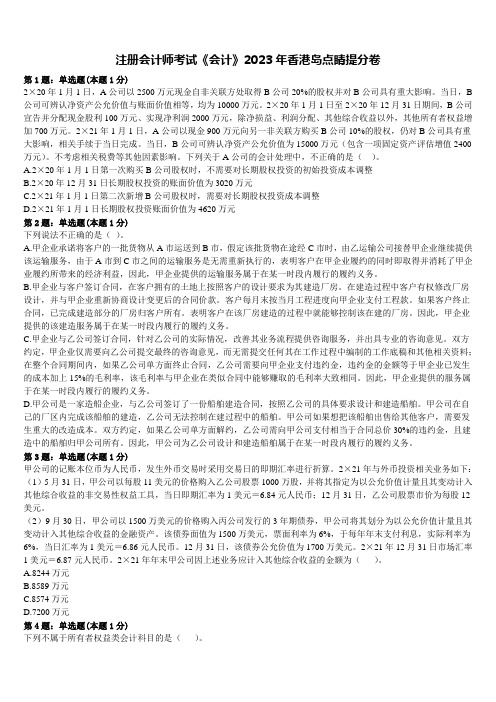
注册会计师考试《会计》2023年香港岛点睛提分卷第1题:单选题(本题1分)2×20年1月1日,A公司以2500万元现金自非关联方处取得B公司20%的股权并对B公司具有重大影响。
当日,B 公司可辨认净资产公允价值与账面价值相等,均为10000万元。
2×20年1月1日至2×20年12月31日期间,B公司宣告并分配现金股利100万元、实现净利润2000万元,除净损益、利润分配、其他综合收益以外,其他所有者权益增加700万元。
2×21年1月1日,A公司以现金900万元向另一非关联方购买B公司10%的股权,仍对B公司具有重大影响,相关手续于当日完成。
当日,B公司可辨认净资产公允价值为15000万元(包含一项固定资产评估增值2400万元)。
不考虑相关税费等其他因素影响。
下列关于A公司的会计处理中,不正确的是()。
A.2×20年1月1日第一次购买B公司股权时,不需要对长期股权投资的初始投资成本调整B.2×20年12月31日长期股权投资的账面价值为3020万元C.2×21年1月1日第二次新增B公司股权时,需要对长期股权投资成本调整D.2×21年1月1日长期股权投资账面价值为4620万元第2题:单选题(本题1分)下列说法不正确的是()。
A.甲企业承诺将客户的一批货物从A市运送到B市,假定该批货物在途经C市时,由乙运输公司接替甲企业继续提供该运输服务,由于A市到C市之间的运输服务是无需重新执行的,表明客户在甲企业履约的同时即取得并消耗了甲企业履约所带来的经济利益,因此,甲企业提供的运输服务属于在某一时段内履行的履约义务。
B.甲企业与客户签订合同,在客户拥有的土地上按照客户的设计要求为其建造厂房。
在建造过程中客户有权修改厂房设计,并与甲企业重新协商设计变更后的合同价款。
客户每月末按当月工程进度向甲企业支付工程款。
如果客户终止合同,已完成建造部分的厂房归客户所有。
- 1、下载文档前请自行甄别文档内容的完整性,平台不提供额外的编辑、内容补充、找答案等附加服务。
- 2、"仅部分预览"的文档,不可在线预览部分如存在完整性等问题,可反馈申请退款(可完整预览的文档不适用该条件!)。
- 3、如文档侵犯您的权益,请联系客服反馈,我们会尽快为您处理(人工客服工作时间:9:00-18:30)。
Other vehicles
KEC also has a small market in producing other vehicles, such as electric vehicles. Following on from other product trends, sales rose from 2009 to 2010 and accounted for 3.8% of overall revenue.
Automobile parts and components
Revenues from 2009 to 2010 increased from 4.2% to 7.1% of the overall revenue respectively. The rechargeable battery market in handset industry accounted for the leap in revenue growth. KEC continues its enhancement of production capacity to meet market growing demands.
Mini-van sales increased 16% from 2009 to 2010, but dropped to 46.5% of overall revenue in 2010.
Sedan
KEC is one of the dominant producers in the sedan market and holds about 15% of the market. KEC released a new model of its premier brand during the year, the 'Honey Bee', and this was well received by the PRC market. Sedan sales increased 24% from 2009 to 2010, but were at a lower overall revenue compared to previous year.
Hong Kong Institute of CPAs – All Copyright Reserved
11 - 1
Products and market share
KEC has three product areas – mini-van, sedan and the components used in the production of mini-van and sedan. KEC produced 109,860 units of automobiles in 2010, representing an increase of 26.9% as compared to 86,567 sold in 2009. For the year ended 31 December 2010 Sales volume (units) 65,797 40,517 3,546 As a % of revenue (%) 46.5 42.6 3.8 For the year ended 31 December 2009 Sales volume (units) 53,543 30,423 2,601 As a % of revenue (%) 49.7 42.8 3.3
Integrity – product safety, ethical working conditions, no wasted raw production materials, environmental practices, compliance with international law requirements, industry development support, ethical leadership Innovation – new product development, innovative service and extras, new market exploration, environmentally aware development, acquisitive, opportunistic Reliability – product operates as promised, brand delivers on promises, leading after-sale service Efficiency – right price, keeping costs down, staff development, product runs efficiently
86,567
245 5,867
4.2 100.0
Mini-van
According to the China Association of Automobile Manufacturers (CAAM), KEC's mini-van rank second in the PRC market in terms of sales volume. KEC has 20% of the PRC market and the leading manufacturer holds 30%. KEC has solidly held this percentage of the market for eight consecutive years, always staying approximately 10 - 12% behind the competition. Part of the reason for its second place in the market is its size compared to the competition (which is roughly twice as large based on annual revenues), sales network coverage and the competition's extensive investment in research and development (R&D). KEC has been unable to dedicate the same amount of funds to R&D in this area, meaning that the competition was first to market with a break-through diesel engine in the early 2000s.
Company structure and history
KEC is a relatively new entrant to the Chinese automobile industry and was established in 1995 by the Chai brothers and a consortium of private investors. The Chai brothers are Hong-Kong based entrepreneurs who oversaw the listing of the company on the HKEx in 2001. Board of Directors, senior management and key employees are outlined in Appendix A. In 2004, KEC acquired a smaller Kunming-based private automobile manufacturer with a specialisation in mini-van business. While company management and financials have been integrated into the KEC structure, the Kunming manufacturing plant operations have remained separate. This is the only acquisition to date. In 2009, KEC entered into a collaborative agreement with Fast Trans SRL in Romania regarding the construction of an assembly plant. The plant became fully operational in February 2011.
Qualification Programme (QP) Case Analysis Competition 2011 The case
Kunming Excellence Cars Co Limited
Kunming Excellence Cars Co Limited (KEC) is a medium-sized Chinese automobile manufacturer. It is a public company which has been listed on the Hong Kong Stock Exchange (HKEx) since 2001. Its head office is in Hong Kong and its manufacturing base is Kunming, capital of Yunnan Province, south-western China. Kunming is an emerging auto manufacturing centre, second only to Shanghai. KEC produced 109,860 units of passenger vehicles in 2010, representing an increase of 26.9% as compared to 86,567 sold in 2009. The large increase in volume of sales is consistent with the performance of the booming Chinese automobile industry throughout 2009 and 2010. KEC is a mini-van and sedan manufacturer. It is also engaged in the production and sale of automotive components and rechargeable battery in automotive and handset market.
